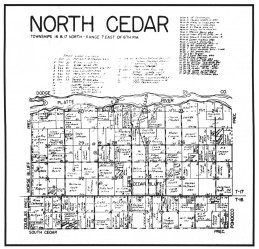 |
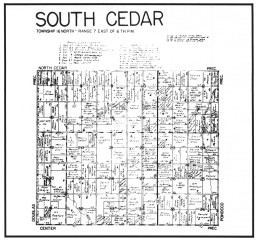 |
| (images link to larger maps) |
CEDAR PRECINCT
Cedar Precinct was organized Feb. 1, 1871. It was originally part of Pohocco. Later, it was divided into North Cedar and South Cedar, making 24, the total number of precincts in the county.
Joseph C. Johnson had homesteaded the original site ofCedar Bluffs. Mrs. Knapp bought it from him for $40 per acre. When it was founded, it was bought from Fauquet and Samson for $40 an acre. Randal H. Knapp was one of the 1868 emigrants to the precinct. He was Co. Treas. for two terms, and first Mayor of Wahoo. Charles Perky came in 1868.
The early settlers of this area had to ford the Platte R. to reach a market; many a load of grain was lost and many a load of household goods immersed.
Two of Mrs. E.H. Henderson's grandparents were also early settlers. Walter Crinklau came in early '70s and homesteaded, as did her father, George Orme. The homestead taken out by Mr. Orme is located south of Cedar and the schoolhouse #60 is on that property which is still in Mrs. Henderson's ownership. Mr. Orme came from Scotland.
Another early pioneer was Lewis Lichtenberg, who came here from Germany on the U.S. ship Marco Polo. He served in the Civil War and afterwards homesteaded northwest of Cedar Bluffs, where Louis Lictenberg now lives.
COUNTY TOWNSHIP OFFICERS
North Cedar
Chairman -- Adolph Tenopir (CB)
Clerk -- Louis Lichtenberg (CB)
Treasurer a-- Walter Jessen (CB)
South Cedar
Chairman -- Calvin LeGrande (CB)
Clerk -- Ray Huscher (CB)
Treasurer -- Louis Frana (Colon)
CEDAR BLUFFS
Cedar Bluffs was so named because of an abrupt bluff 2½ miles north on the Platte River where cedar trees grew. In 1886, lots were sold to form a town site along the Chicago and North-Western Railroad. The town flourished due to the large trade from the surrounding territory. By 1887, when the village was incorporated, there were 200 people living there. The business district grew almost overnight and at one time the village could boast of having 40 businesses.
W.H. Ferris, a pioneer of Saunders Co. sent for Dr. A.E. Stuart, who was residing at that time in Windsor, Canada. Upon the doctor's arrival they started a drug store. Dr. Stuart was also appointed the first postmaster of Cedar Bluffs.
The old grange hall was brought into town and used as the town hall; then later as the Reading Room or Community Hall. A brick building, constructed with bricks made in a brick factory located east of Cedar, in Pohocoo Precinct, was built to house the jail, fire engine, and city offices. Today this two-story brick building stands vacant across the street from the present Fire Hall and garages, which hold a new fire truck, tanker, Rescue Squad and the other backup fire equipment necessary today. The old hall was sold and moved to 105 E. Oak and today is a family dwelling.
The pioneer merchant of the village was John Killian. He built the building which today houses the laundromat. Originally, it was a grocery store on the west side of the building with dry goods on the east. He also built the largest house in the village, located on the highest hill. It still stands and today is the home of the Larry Bauer family.
Other large homes that were built and are still gracious homes were Dr. Stuart's home on the southeast corner of 3rd and Elm, and next to it, stands Frank Knapp's former home. The first brick home, built by Henry Holdst, was made of bricks manufactured east of town on the present Schilke farm. Today it is the home of the Ernest Nick family (108 W. Oak).
The Cedar Bluffs Standard was a weekly newspaper created about 90 years ago. It was discontinued in the '60s.
In 1976, Cedar built a 150,000 gallon water tower and the sewage disposal plant was completed in 1978.
Today the village is the home of 626 people; it is a commuter town. Since there are few jobs in the area it is necessary to drive to Fremont, Schuyler and Omaha to find work.
Village board for 1983: Chairman -- Bob Wiegand, Clerk -- Betty Stamm, Keith Hartford, Sherman Thurlow, Bob Hartford, Maintenance -- Clarence Thurlow.
The police protection is provided by the Co. Sheriff's dept.
A WALK DOWN MAIN STREET
IN CEDAR BLUFFS
Let's turn back the clock and find ourselves standing on Main Street in 1905. We're standing on a hill in front of the Reading Room (today's fire hall.) Looking east across the railroad tracks on the south side of Main street are two lumber yards. North of Main we see the depot, a coal yard and stockyards. A block east stands the two-story frame schoolhouse and the New Presbyterian Church. As we turn west to walk down the board walk, we meet men dressed in dark pants, vests and coats, wearing caps and hats of various shapes and sizes. Mustaches and beards are very popular with the older men. The first store we look into is a paint store (Post Office), next to it is MacKintyre's barber shop (vacant building). Walking on, we peek into the butcher shop (Settle's Plumbing storage building). The smell of sausages and ham makes our mouth water. A barber shop (Hattie Johnson residence) is next. On the sidewalk in front of the next two buildings (Sweeney's Barber Shop and Mr. R. Greens's Law Office) stand stacked barrels. These are the beer parlors visited only by men. Next door is the pool hall (Moser's Funeral Home); then Pete Bade's grocery store (Bank parking lot). The cafe and Brokaw's drug store (new drive-up window to bank) are the next buildings we investigate. We pass Farmer's Merchant Bank (Commercial St. Bank) as we approach Killian's store (vacant store and laundromat).
The women we meet are dressed in long dresses with the young girls wearing their skirts at mid-calf. Standing on the corner we look south across the alley to the dentist office and the Opera House (Elmer Jurgen's trailer). Across the street west, is a large brick building (Am. Legion Hall), which has a grocery store below a large meeting hall where the Masonic Lodge first met, but now the Woodman of the World and Royal Neighbors use for their meetings. South across the alley is the telephone office and a dressmaker shop.
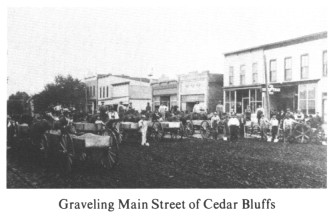 |
| Graveling Main Street of Cedar Bluffs |
Back on Main Street, west of us, is a hotel; then a large livery stable (vehicle barn for Settle's Plumbing). Across the street is the blacksmith shop (Gaughen Body Shop);just east is Adam Rumpeltes Bakery and on the corner is a large implement store (OPPD office). Crossing the street we approach Lockner's Hardware (Senior Center), the second floor is used as the Masonic Hall (same today).
As we pass Ostrand's garage (Furstenau's garage), we see a shiny new Dodge Touring car being admired by Hans Jurgens. The bank (Grosse Real Estate Office) stands next to a large two-story building (Settle's Electric) which houses a furniture store on the main floor with a harness shop to the rear and a mortician's office in the basement. Otredosky's Drug Store (Merf's) built in 1890, stands beside Schere's grocery (Settle's Plumbing Office). We stroll past a vacant lot and we glance around the busy street. Horse-drawn wagons and carriages are passing, stirring up a cloud of dust from the dirt street.
David Yung's hardware store (The Den) is a large brick building proudly proclaiming its building date of 1903. Next door stands the Paradise Confectionery (Hub Trading Co.). The smell of baked goods and candies assault our noses as we pass. Walking quickly we pass a harness and produce shop and come to the two-story hotel (Auditorium) where Dr. Buchanan has his office.
Standing before the Post Office (Town Pump) with Grover Smith's Photography studio upstairs, we realize our walk through yesterday has drawn to a close. We have to admire our predecessors who had the courage to leave their homes in Europe and come to America, to cross thousands of miles to reach Cedar Bluffs. They built homes, churches and businesses, learned a new language and faced hardships few of us today could master. It is with pride that we look at their achievements and hopefully strive to follow in their footsteps.
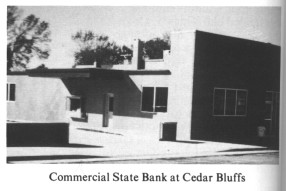 |
| Commercial State Bank at Cedar Bluffs |
CHURCHES OF BYGONE YEARS
In 1887, the First Methodist Episcopal Church was moved from the Chapman farm to the southern part of town. The house at 206 W. Pine stands where it once stood. This church served the people for over 20 years before the new church was built in 1904. The old building was then used as the Evangelical Church. In 1913, this church was rented to hold Lutheran services once a month for the families who had moved to town and had no way to get to the church in the country. Later in the same year, St. Matthew's purchased this house of worship. Henceforth, the pastor conducted services in both churches. German and English services were alternated. When the St. Matthew's and the Zion Lutheran Church united in 1926, services were no longer held in the little church so it was sold and moved north of Main street where an Implement store used it for part of their business.
The Zion Lutheran Church stood on the northwest corner of 2nd and Pine. In 1944, the rural St. Matthew's church building was moved to town. It was placed immediately south of the former Zion church building which was used as a parish hall. In 1948, they decided to build a new manse so the parish hall was sold and moved to 104 W. Elm and the old manse was moved to 209 W. Oak. In 1956, a new St. Matthew's Lutheran Church was built on the southeast corner of 2nd and Pine. The old church was moved to the country.
In 1904, the First United Methodist Church was built on the northeast corner of 2nd and Elm. Originally, the church was called the Royce Memorial Methodist because Rev. J.W. Royce was serving as pastor at that time. On May 31, 1959, the congregation voted to close the church. In 1960, the building was taken down and moved to the Methodist Camp at Fontanelle, Ne. where it was used to build a chapel and is still in use today.
ST. MARY'S CATHOLIC CHURCH
The beginning of St. Mary's Parish, more than a
century ago, was originally known as the Malloy
page 50
Settlement. It is under this title that first recorded baptisms of the original pioneer babies are identified in the margins of the baptismal records. These original records are on file at St. Patrick's Church in Fremont, Ne. from where the priests forded the Platte River to attend the spiritual needs of pioneer families in Saunders County. The first mass was offered in Michael Malloy's dug-out in 1869. The priest was Father Shine from St. Patrick's Church, Fremont. In August or September 1873, the Catholic families decided to build a church on the ground now known as St. Mary's Cemetery, a plot of three acres, donated by Patrick Malloy Sr. This church was originally known as St. Patrick's and later changed to St. Augustine's.
In 1917 Bishop O'Reilley directed this church closed and St. Mary's Church at Cedar Bluffs to be built. The new church was to take in part of Holy Rosary Parish, which was directed to be closed.
St. Augustine's Church (Malloy Settlement) was called the "Mother Church" in Saunders County. Some of the early settlers who helped build this church were the Shanahans, Maghers, Hursts, Ladenburgs, Krauses, and the Malloys. These early families were mainly Irish, German and Czech. Anna Brown is a third-generation descendant of one of the original founders of St. Augustine's Church.
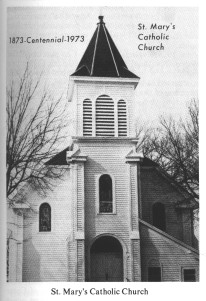 |
| St. Mary's Catholic Church |
The Cornerstone for the new church was laid on Sept. 16, 1917. The church was built under the direction of Father Joseph Stockinger and dedicated in June 1918, by Bishop J. O'Reilley, thus forming St. Mary's Parish. Father Timothy Corcoran was assigned to Cedar Bluffs to be the first resident pastor and to build the rectory.
Estina was attached to Cedar Bluffs as a mission church in 1921. Our pastors continued to serve Estina (St. Theresa's) until about 1960 when it was destroyed by fire and the parish was dissolved.
Father Corcoran was then succeeded by Father J.M. Van DeValle, Father Henry Wattelle, Father Paul Ulenberg, Father William A. Murphy, Father (now Msgr.) Raymond Wageman, Father Oscar Schlacter, Father Anthony T. Trausch, Father John M. Kozlik, Father Verness Ketter, Father Harold Birkel, and our present pastor, Father Edward Orzechowski.
In 1963, Father Verness Ketter helped initiate, and watched the construction of a central Catholic high school for the eleven parishes of the deanery. He was the first principal of Bishop Neumann Central Catholic High School in Wahoo.
Vocations from our parish are as follows: Father Thomas Rooney, Sister Patricia Miller, and Sister Mary Kevin (Theresa Rooney).
FIRST PRESBYTERIAN CHURCH
OF CEDAR BLUFFS
1904-1983
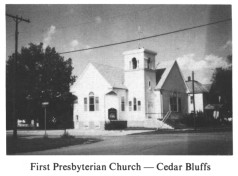 |
| First Presbyterian Church -- Cedar Bluffs |
A number of families settled in the village of Cedar Bluffs who had previously been members of other orthodox churches. Some placed their letters temporarily with the Methodist Church as it was the only English speaking church in the village. For several years there had been a feeling among these people that another English church was needed. The majority of sentiment favored the Presbyterian. But a leader was lacking to take the enterprise, until Mrs. R.J. Fleming moved from Salem, Oregon, with her husband and family. Mrs. Fleming and Robert Mowbray circulated a paper asking all who were willing to unite with the Presbyterian Church to sign the Charter. They secured over 45 signatures and also started a subscription to raise money to build a church, securing over $2000.
A building committee was elected and two lots were purchased from Mrs. F. Yung for $400. On the evening of Sept.25, 1904, the congregation assembled in the opera house for their first Presbyterian service. The dedication services for the First Presbyterian Church of Cedar Bluffs were held on Jan. 1, 1905, in the beautiful new building which cost (including furniture and fixtures) $4,719.30. A week later the Sunday School was organized with teachers and scholars totaling 71. The Sunday School included the entire family, adults and children. It was held in the west portion of the church, which could be closed off from the main part by two
large sliding doors. A portable pump organ was used until a piano could be purchased.
The following pastors were installed at the First Presbyterian Church: Rev. Samuel Wiley 1905-06, Rev. Alexander Corkey 1907-10, Rev. J.H. MacConnell 1910-11, Rev. D.K. Miller 1911-50, Rev. Albert C. Bullock 1951-54, Rev. Dr. Harry Hansen 1955-57, Rev. Walter G. Millett 1957-61, Rev. Merle E. Elrod 1962-65, Rev. Henry P. Guinotte 1966-72, Rev. David S. Jamieson 1973-77, Rev. Kermit V. Clark 1978-79, Rev. D. Stanley Tyner l980-.
In 1906, the manse and barn were finished on the lot east of the church. Tent meetings were held in the Fleming neighborhood with visiting pastors serving the pulpit in 1909. Rev. D.K. Miller served the congregation for 40 years and upon retirement, he was made "Pastor Emeritus." During the fall of 1916, a basement and new furnace were put under the church. In 1962, an educational addition was added to the north end of the church, giving space for much-needed Sunday School rooms.
Camp Calvin Crest was dedicated on July 5, 1959. It is a year-around Camp Conference Retreat Center located four miles northeast of Cedar Bluffs on part of the former Barrett and Jurgens farms. The camp consists of 250 acres and is on the bluff overlooking the Platte River. The Center is designed and operated for religious and educational programming. The Camp can accommodate up to 90 persons in the winter and up to 180 persons during the summer months. Many members of the First Presbyterian Church have played an important role in the development of the Camp. The church uses the camp in many ways by sending its youth to summer camp and for retreats. The annual church picnic is held at the camp. Calvin Crest Camp also provides a service to Cedar Bluffs by allowing the children to take swimming lessons in the camp pool.
Under the direction of Rev. Henry Guinotte, several Cedar Bluffs Presbyterian youth volunteered their summers to work in a mission station, Hospitality House, in Fairbanks, Alaska. Besides doing maintenance work at the Hospitality House, the youth visited scenic and historic sites as well as remote Eskimo villages. The group of 12 young people, plus two counselors traveled by van, plane and boat to cover about 9,000 miles each summer, staying in church basements and cooking their own food.
In Sept., 1979, the First Presbyterian Church held its Diamond Jubilee. Former pastors, former members, neighbors and friends were asked to come to the special jubilee service.
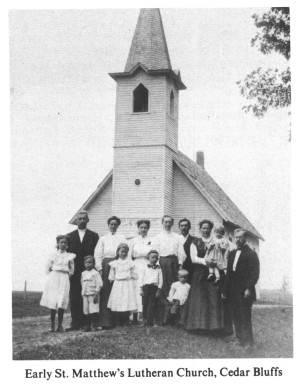 |
| Early St. Matthew's Lutheran Church, Cedar Bluffs |
ST. MATTHEW LUTHERAN
CHURCH
In 1876, settlers near Cedar Bluffs, invited Pastor A. Frese to conduct worship services in a country schoolhouse. After the congregation was organized, a parsonage was erected and services were conducted on the second floor. On Sept.22, 1878, the first pastor, August Hofius, was installed, serving until 1881. Rev. A. Detzer succeeded, remaining for one year during which a church was erected four miles southwest of Cedar and dedicated on May 7, 1882. Church also served as a school. The next pastor, Paul Schulte, served until 1885. On Dec.13, 1885, Rev. August Leuthaeuser was installed, serving for 15 years, until Jan. 1, 1901.
On March 24, 1901 Rev. Kinrad Jahn was installed. A bell was donated by Andrew Huescher that same year. On April 16, 1902, a fire broke out on the church property. The barns and outbuildings burned to the ground, the church and parsonage were saved. Rev. Jahn left on Oct.1903, succeeded by Rev. F. Daberkow. In 1904, a new parsonage was erected and the old converted into a school. In 1913, the congregation began to conduct services once a month in Cedar for 11 families at the rented Evengelical Church. In 1913, St. Matthew's purchased this church for $600. Services then were conducted in the country and in town.
On March 14, 1919 a tornado destroyed the church, school and outbuildings in the country-parsonage, summer kitchen and cobhouse spared. Pastor Daberkow, wife, and daughter, Helen, (Mrs. Albert Hoffman) were in the house when the tornado struck. Son, Christian, cleaning the school, was not seriously hurt. In 1919, a new house of worship was built, school attached. Dedication was on Nov. 2, 1919 one week after Rev. Daberkow delivered his farewell sermon.
page 51
| 
